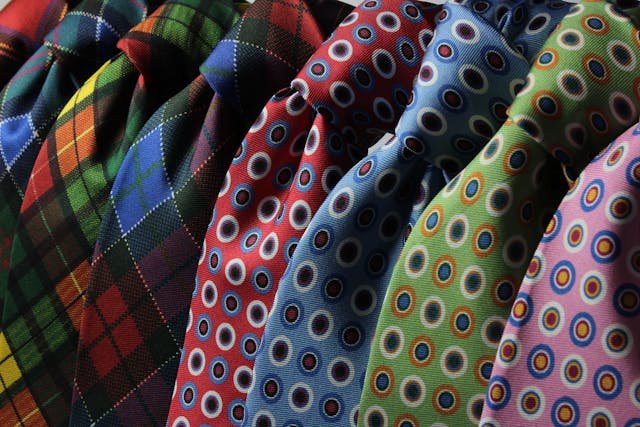The Art of the Knot: Achieve Flawless Neckwear Every Time
Does tying a tie seem scary, but you know it’s key to looking sharp for any occasion? Knowing how to tie a tie is invaluable, whether you’re preparing for a job interview or a formal event or want to enhance your everyday attire. This guide will walk you through different knots, their uses, and tips to ensure you look sharp every time.
The Importance of Knowing How to Tie a Tie
A well-tied necktie can significantly improve your overall appearance. It conveys professionalism, attention to detail, and a sense of style. Learning various knots also gives you versatility and allows you to adapt your look to different occasions.

Different Types of Knots
Numerous neckwear knots exist, each with unique characteristics and appropriate context. Some are simple and perfect for everyday use, while others are more intricate and ideal for special occasions. Here, we’ll cover the basics and more advanced knots to ensure you have a knot for every need.
Simple Knot: The Four-in-Hand
The Four-in-Hand knot is one of the most superficial and commonly used. It’s easy to learn and works well with most collar styles.
- Drape the tie around your neck, with the wide end on your right and the narrow end on your left.
- Cross the wide end over the narrow end and bring it around and under it.
- Bring the wide end over again and pull it through the loop around your neck.
- Tighten the knot by pulling down on the wide end and adjusting it to fit snugly at the collar.
The Elegant Half Windsor Knot
The Half Windsor knot offers a balance between simplicity and sophistication. It’s slightly more formal than the Four-in-Hand and works well with medium to wide collars.
- Start with the tie around your neck, with the wide end longer than the narrow end.
- Cross the wide end over the narrow end, then bring it up through the loop between your collar and the tie.
- Pull the wide end down, then bring it behind the narrow end to the other side.
- Bring the wide end up again through the loop and pull it through the knot in the front.
- Tighten and adjust the knot to sit neatly at the collar.
Full Windsor Knot
The Full Windsor knot is ideal for formal occasions. It’s larger and more symmetrical, giving a polished and commanding look.
- Drape the neckwear around your neck, with the wide end longer than the narrow end.
- Cross the wide end over the narrow end and bring it up through the loop.
- Pull it down and bring it behind the narrow end to the other side.
- Bring the wide end up through the loop again, pulling it down on the other side.
- Cross the wide end over the front, bring it up through the loop, and pull it through the knot in the front.
- Adjust and tighten to achieve a neat, symmetrical knot.
The Pratt Knot: A Modern Twist
The Pratt knot, also known as the Shelby knot, is a versatile and modern option that works well with any tie and collar.
- Start with the tie inside out, with the wide end on your right and the narrow end on your left.
- Cross the wide end under the narrow end and pull it up through the loop.
- Bring it down and around the narrow end, then bring it up through the loop again.
- Pull it through the knot in the front and tighten.
When to Use Each Knot
Choosing the right knot depends on the occasion, style, and collar type. The Four-in-Hand is perfect for casual and semi-formal settings, while the Full Windsor is best for formal events. The Half Windsor strikes a balance and is suitable for formal and informal occasions, and the Pratt knot offers a modern touch for any setting.
Choosing the Right Tie for the Occasion
The fabric you select for your neckwear can significantly impact your overall look. Silky options are ideal for formal occasions, while wool or knit choices work well in casual or business-casual settings. Remember, the color and pattern of your neckwear should complement your shirt and suit for a cohesive ensemble.

Materials and Styles
Neckwear can be made of various materials, each offering a distinct look and feel. Silky options provide a smooth, lustrous finish ideal for formal events. Wool varieties offer a textured look, perfect for casual or business-casual settings.
Tips for Matching Neckwear with Shirts and Suits
Matching your neckwear with your shirt and suit involves considering color, pattern, and proportion. A simple rule is to pair a patterned tie with a solid shirt or a solid tie with a patterned shirt. Ensure the colors complement each other and the neckwear is proportional to your suit and collar size.
Common Mistakes to Avoid
Avoid common errors like tying the knot too short or too long, not aligning the neckwear properly, or choosing a knot that clashes with your outfit. Ensure the tie reaches your belt buckle and the knot is centered at the collar.
How to Maintain and Store Ties
Proper maintenance and storage can extend the life of your neckwear. Always untie your tie after wearing it, and avoid pulling the knot loose. Store your neckwear rolled or hung to prevent wrinkles. For cleaning, follow the care instructions specific to the neckwear’s material.

Conclusion
It is a crucial skill that can elevate your wardrobe and personal appearance. Understanding different knots and when to use them is key to always looking your best. It’s important to select the appropriate neckwear for each occasion, properly care for your ties, and avoid common mistakes. With practice, tying a tie will become effortless, allowing you to exude confidence and style at any event.
Continue your journey of learning with our latest posts! Click here to explore more on howtothings.net.
